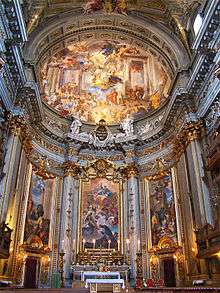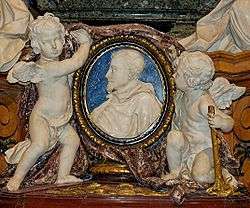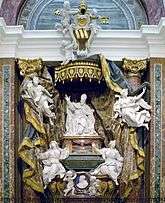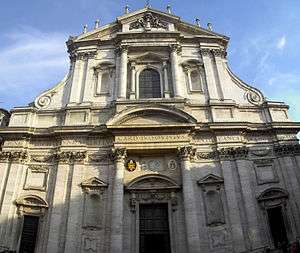Sant'Ignazio Church, Rome
| Sant'Ignazio Church | |
|---|---|
| Church of St. Ignatius of Loyola at the Campus Martius | |
|
Italian: Chiesa di Sant'Ignazio di Loyola in Campo Marzio Latin: Ecclesia Sancti Ignatii a Loyola in Campo Martio | |
|
Façade of Sant'Ignazio | |
 Sant'Ignazio Church | |
| 41°53′56.4″N 12°28′47.2″E / 41.899000°N 12.479778°ECoordinates: 41°53′56.4″N 12°28′47.2″E / 41.899000°N 12.479778°E | |
| Location |
Via del Caravita, 8A Rome |
| Country | Italy |
| Denomination | Roman Catholic |
| Website |
santignazio |
| History | |
| Consecrated | 1722 |
| Architecture | |
| Status | Parish church and titular church |
| Functional status | Active |
| Architect(s) | Orazio Grassi, S.J. |
| Style |
Mannerist Baroque (façade) |
| Groundbreaking | 1626-08-02 |
| Completed | 1650 |
| Specifications | |
| Length | 90 metres (300 ft) |
| Width | 50 metres (160 ft) |
| Nave width | 25 metres (82 ft) |
| Other dimensions | Façade direction: N |
| Number of domes | 1 |
| Administration | |
| Diocese | Rome |
The Church of St. Ignatius of Loyola at Campus Martius (Italian: Chiesa di Sant'Ignazio di Loyola in Campo Marzio, Latin: Ecclesia Santi Ignatii a Loyola in Campo Martio) is a Roman Catholic titular church, of deaconry rank, dedicated to Ignatius of Loyola, the founder of the Society of Jesus, located in Rome, Italy. Built in Baroque style between 1626 and 1650, the church functioned originally as the chapel of the adjacent Roman College, that moved in 1584 to a new larger building and was renamed the Pontifical Gregorian University.[1] The most recent Cardinal of the Titulus S. Ignatii de Loyola in Campo Martio was Cardinal Roberto Tucci, S.J.; he had been its Cardinal Deacon until he became its Cardinal Priest (i.e., opted for the order of cardinal priests, with this church being elevated "pro hac vice" to title).
History
The Collegio Romano opened very humbly in 1551, with an inscription over the door summing up its simple purpose: "School of Grammar, Humanity, and Christian Doctrine. Free". [2] Plagued by financial problems in the early years,[3] the Collegio Romano had various provisional centres. In 1560, Vittoria della Tolfa,[4] Marchesa della Valle, donated her family isola, an entire city block and its existing buildings, to the Society of Jesus in memory of her late husband the Marchese della Guardia Camillo Orsini, founding the Collegio Romano.[3] She had previously intended to donate it to the Poor Clares for the founding of a monastery.[5] The nuns had already started to build what had been intended to become the Church of Santa Maria della Nunziata,[3] erected on the spot where the Temple of Isis had stood.[6][1]
Although the Jesuits got the marchesa's land, they did not get any money from her for completing the church. Budgetary restraints compelled them to hire their own architect. Construction of the church was taken over by the Jesuit architect Giovanni Tristano. Built entirely by Jesuit labour, the Church of the Annunciation was first used for worship in 1567. A three-aisled church dedicated to the Most Holy Annunciation (Italian: Santissima Annunziata) was built by the Collegio Romano between 1562 and 1567 on the foundations of the pre-existing construction. Since the earlier church had already been built to the height of the ground floor in 1555, there was no way for the Jesuits to expand the structure to hold the increasing number of students attending the Collegio Romano. The facade was very similar to that of the contemporary Church of Sant'Andrea al Quirinale, which was also designed by Giovanni Tristano. In accordance with the wishes of the marchesa, the façade proudly displayed the Orsini arms. The Church of the Annunciation was enlarged in 1580 when Pope Gregory XIII expanded the Collegio Romano itself, especially the side chapels.
The old church became insufficient for over 2,000 students of many nations who were attending the College at the beginning of the 17th century.[1] Pope Gregory XV, who was an old pupil of the Collegio Romano, was strongly attached to the church. Following the canonization of Ignatius of Loyola in 1622, he suggested to his nephew, Cardinal Ludovico Ludovisi, that a new church dedicated to the founder of the Jesuits should be erected at the college itself. The young cardinal accepted the idea, asked several architects to draw plans, among them Carlo Maderno. Ludovisi finally chose the plans drawn up by the Jesuit mathematician, Orazio Grassi, professor at the Collegio Romano itself.
The foundation stone was laid only on August 2, 1626, four years later, a delay which was caused by the fact that a section of the buildings belonging to the Roman College had to be dismantled. The old church was eventually demolished in 1650 to make way for the massive Church of St. Ignatius of Loyola, which was begun in 1626 and finished only at the end of the century. In striking contrast to the Church of the Annunciation, which occupied only a small section of the Collegio Romano, the Church of St. Ignatius of Loyola took up a quarter of the entire block when it was completed.
The church was opened for public worship only in 1650, at the occasion of the Jubilee of 1650. The final solemn consecration of the church was celebrated only in 1722 by Cardinal Antonfelice Zondadari. The church's entrance now faces on to the Rococo Place of San Ignazio was planned by the architect Filippo Raguzzini.
Interior

The church has a Latin cross plan with numerous side chapels. The building was inspired by the Jesuit mother church, the Church of the Gesù in Rome (finished in the late 16th century). The imposing order of Corinthian pilasters that rings the entire interior, the theatrical focus on the high altar at the rear of the broad eastern apse, the church's colored marbles, animated stucco figural relief, richly ornamented altars, extensive gilding, and bold Tromp l’oeil paintings in the "dome" at its crossing and in the nave ceiling all produce a festive, sumptuous effect. Funds to build a dome were lacking, hence a painter to paint the illusion of a dome was hired.[7] The church stages the triumph of its dedicatee most effectively.
The nave's west wall has a sculptural group depicting Magnificence and Religion (1650) by Alessandro Algardi. Algardi also helped design the high reliefs in stucco that run on both lateral nave walls just above the entries to the chapels and beneath the nave's grandiose entablature.
Other artworks in the church include a huge stucco statue of St. Ignatius by Camillo Rusconi (1728). A chapel holds a glass coffin with a portrait of Cardinal Bellarmino (died 1621).
Frescoes of Andrea Pozzo

Andrea Pozzo, a Jesuit lay brother, painted the grandiose fresco that stretches across the nave ceiling (after 1685).[8] It celebrates the work of Saint Ignatius and the Society of Jesus in the world presenting the saint welcomed into paradise by Christ and the Virgin Mary and surrounded by allegorical representations of all four continents. Pozzo worked to open up, even dissolve the actual surface of the nave's barrel vault illusionistically, arranging a perspectival projection to make an observer see a huge and lofty cupola (of a sort), open to the bright sky, and filled with upward floating figures. A marble disk set into the middle of the nave floor marks the ideal spot from which observers might fully experience the illusion. A second marker in the nave floor further east provides the ideal vantage point for the trompe l'oeil painting on canvas that covers the crossing and depicts a tall, ribbed and coffered dome. The cupola one expects to see here was never built and in its place, in 1685, Andrea Pozzo supplied a painting on canvas with a perspectival projection of a cupola. Destroyed in 1891, the painting was subsequently replaced. Pozzo also frescoed the pendentives in the crossing with Old Testament figures: Judith, David, Samson, and Jaele.[9]

Pozzo also painted the frescoes in the eastern apse depicting the life and apotheosis of St Ignatius.[1] The Siege of Pamplona in the tall panel on the left commemorates the wounding of Ignatius, which led to the convalescence that transformed his life. The panel over the high altar, Vision of St Ignatius at the Chapel of La Storta, commemorates the vision that gave the saint his divine calling. St Ignatius sends St Francis Xavier to India recalls the aggressive Jesuit missionary work in foreign countries, and finally, St Ignatius Receiving Francesco Borgia recalls the recruitment of the Spanish noble who would become General of the Company of Jesuits. Pozzo is also responsible for the fresco in the conch depicting St. Ignatius Healing the Pestilent.
Side chapels

The first chapel on the right has an 18th-century altarpiece showing Saints Stanislaus Kostka and John Francis Regis Worshiping the Virgin and Child. The second chapel has an altarpiece depicting St Joseph and Virgin and a lunette (right wall) depicting the Last Communion of St Luigi Gonzaga, both by Francesco Trevisani (1656–1746); the cupola was painted by Luigi Garzi. The third chapel has an 18th-century altarpiece of Presentation of the Virgin in the Temple by Stefano Pozzi.
The chapel in the right transept, dedicated to St. Aloysius Gonzaga, has a large marble high-relief depicting St. Aloyzius Gonzaga in Glory[10] (1697–99) by the French sculptor Pierre Legros. Andrea Pozzo painted the ceiling which also shows the Glory of the Saint. Buried in the side altar next to Gonzaga is Cardinal St. Robert Bellarmine.
The chapel in the left transept houses the relics of Saint John Berchmans.
The chapel just to the right of the church's presbytery (at the south-east corner) houses the funeral monuments of Pope Gregory XV and his nephew, Cardinal Ludovisi, the church's founder. Pierre Legros and Pierre-Étienne Monnot made Gregory XV's monument some sixty years after Gregory's death.
The chapel in the left transept has a marble altarpiece of the Annunciation by Filippo Della Valle, with allegorical figures and angels (1649) by Pietro Bracci, and a frescoed ceiling with The Assumption by Pozzo. The second and first chapels to the left have paintings by Jesuit Pierre de Lattre, who also did the sacristy paintings.[11]
List of cardinal deacons
The Cardinal Deaconry of Sant Ignazio di Loyola a Campo Marzio was established June 28, 1991.[12] Its cardinals include:
- Paolo Dezza, S.J. (28 June 1991 – 17 December 1999)
- Roberto Tucci, S.J. (21 February 2001 — 12 February 2011; as Cardinal priest 21 February 2011 — 14 April 2015 †)
See also
Gallery
 Interior
Interior Bellarmine chapel dome
Bellarmine chapel dome Medallion of Ludovico Ludovisi
Medallion of Ludovico Ludovisi- Glory of St Aloysius Gonzaga (1698) by Legros
 Annunciation (1750) by Della Valle
Annunciation (1750) by Della Valle Monument to Pope Gregory XV (1697) by Monnot
Monument to Pope Gregory XV (1697) by Monnot
References
- 1 2 3 4 Society of Jesus. "Official Website of the Church of St Ignatius of Loyola at Campus Martius". Retrieved 2009-01-31.
- ↑ O'Malley, John (1993). The First Jesuits. Cambridge: Harvard University Press. p. 366. ISBN 978-0-674-30313-3.
- 1 2 3 Bailey, Gauvin (2003). "Jesuit Teaching and a Brief History of the Roman Collegiate Institutions". Between Renaissance and Baroque. Toronto: University of Toronto Press. p. 112. ISBN 0-8020-3721-6.
The Collegio was set back on its feet by Gregory XIII (1573-85), a pope for whom education was a primary concern (...). Gregory reluctantly agreed to be called 'founder' of the college, a title offered in acknowledgment of his generosity, even though he thought it more properly belonged to the Marchesa della Valle. (...)
- ↑ Valone, C. (2003-07-16). "Architecture as a public voice for women in sixteenth-century Rome". Renaissance Studies. Blackwell Publishing Ltd. 15 (3): 301–327. doi:10.1111/1477-4658.00372.
- ↑ Bailey. p 112.
- ↑ The present façade stands where the Roman aqueduct Acqua Vergine once stood, flowing down in a cascade to Imperial Rome.
- ↑ Steves, Rick. Pocket Rome.
- ↑
 Gietmann, G. (1913). "Andreas Pozzo". In Herbermann, Charles. Catholic Encyclopedia. New York: Robert Appleton Company.
Gietmann, G. (1913). "Andreas Pozzo". In Herbermann, Charles. Catholic Encyclopedia. New York: Robert Appleton Company. - ↑ L. Montalto, "Andrea Pozzo nella chiesa di Sant'Ignazio al Collegio Romano," Studi romani 6 (1958): 668–679.
- ↑ St. Aloyzius Gonzaga in Glory
- ↑ Levy, Evonne (2004). Propaganda and the Jesuit Baroque. Berkeley: University of California Press. p. 287. ISBN 0-520-23357-3.
- ↑ David M. Cheney, Catholic-Hierarchy: Cardinal Deacons of S. Ignazio Accessed: 03/12/2016.
Bibliography
- Remigio Marini, Andrea Pozzo pittore (Trent, 1959).
- N. Carbonieri, Andrea Pozzo architetto (Trent, 1961).
- B. Canestro Chiovenda, "Della “Gloria di s. Ignazio” e di altri lavori del Gaulli per i gesuiti," Commentari 13 (1962), 290 ff.
- Zaccaria Carlucci, La chiesa di S. Ignazio di Loyola in Roma ([Roma] : [Chiesa di S. Ignazio], [1995]).
- Evonne Levy, Propaganda and the Jesuit Baroque (Berkeley-Los Angeles: University of California Press, 2004).
External links
|
|
![]() Media related to Sant'Ignazio at Wikimedia Commons
Media related to Sant'Ignazio at Wikimedia Commons
